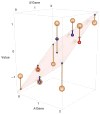Genotypic Context and Epistasis in Individuals and Populations
- PMID: 27419868
- PMCID: PMC4948997
- DOI: 10.1016/j.cell.2016.06.047
Genotypic Context and Epistasis in Individuals and Populations
Abstract
Genes encode components of coevolved and interconnected networks. The effect of genotype on phenotype therefore depends on genotypic context through gene interactions known as epistasis. Epistasis is important in predicting phenotype from genotype for an individual. It is also examined in population studies to identify genetic risk factors in complex traits and to predict evolution under selection. Paradoxically, the effects of genotypic context in individuals and populations are distinct and sometimes contradictory. We argue that predicting genotype from phenotype for individuals based on population studies is difficult and, especially in human genetics, likely to result in underestimating the effects of genotypic context.
Copyright © 2016 Elsevier Inc. All rights reserved.
Conflict of interest statement
Conflicts of interest: None for either author
Figures

References
-
- Bateson W. The progress of genetics since the rediscovery of Mendel’s paper. Progressus Rei Botanicae. 1907;1:368–382.
-
- Cairns BR, Ramer SW, Kornberg RD. Order of action of components in the yeast pheromone response pathway revealed with a dominant allele of the STE11 kinase and the multiple phosphorylation of the STE7 kinase. Genes Dev. 1992;6:1305–1318. - PubMed
Publication types
MeSH terms
Grants and funding
LinkOut - more resources
Full Text Sources
Other Literature Sources

